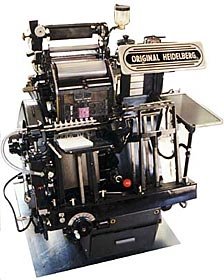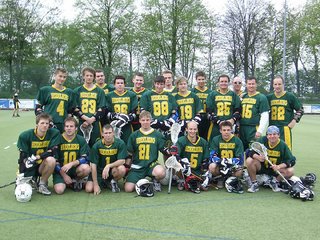Present: Mr. Jones [Chairman], Mr. Coombes [Hon. Sec.]
Absent: Mr. Holroyd [Treasurer}
Apologies were there none
It was proposed that the society buy a two and a half ton Heidelberg platen printing press as advertised recently on eBay.

The Hon. Sec. pointed out that the Chairman didn’t have space for it in his kitchen and even if he did it would be through the floor and in his garage before he could press GO [and he didn’t have space for it in his garage either]. And anyway the Treasurer hadn’t turned up so we couldn’t sanction spending 2500 notes of the Society’s non-existent funds.
Matters arising:
Platen printing presses.
“Presses that operate plane to plane are called platen presses. A vertical clamping contrivance clamps the bed, which carries the form into which the composed type is locked, and the platen, which carries the sheet of paper while it is being printed. When this clamping contrivance is open, the typeform is inked by a series of rollers that descend and then reascend, and the printed sheet is removed and a new sheet placed in position on the platen”
Encyclopedia Britannica
Heidelberg.
A town in South West Germany, in the Baden-Württemberg district, with a population of approximately 140,000 souls. Built on the banks of the Neckar river Heidelberg is dominated by the magnificent 16th Century Heidelberger Schloss.

It’s also famous for having the Oldest University in Germany, founded in 1386 because the Italians and French fell out over who should be Pope.
For seventy three years the Popes resided in Avignon, in a posh place called Le Palais des Papes, which was ok because they were all French at the time. Then in 1377, for reasons known only to himself though many suspect it was Catherine of Siena who influenced him, the seventh Pope, Pope Gregory XI, decided to up sticks and move back to Rome where, a year later, just as he was contemplating perhaps returning to Avignon, he, somewhat inconveniently as it turned out, died.

The Italians considered it a home fixture and thinking it was all over in France had sent out the change of address cards. But the French didn’t want to throw in the Papal Towel so easily, what with having a Grande Palais des Papes and all. So the Italians elected a Pope – and so did the French. Well you can imagine the trouble. Europe was in turmoil and the turmoil was called the Papal Schism.
Not to be confused with the Great Schism, when in 1054 the two main religious leaders of the time, Pope Leo IX and Patriarch Michael I, managed to excommunicate each other [a neat trick if you can do it] over who had the best conkers and whether the Filioque Clause should be included in the Nicene Creed. But that’s a whole other Can of Worms, best saved for another day.
So anyway, back in 1378, the Italians had Pope Urban VI in Rome and the French had Pope Clement VII in Avignon. This was clearly a Bad Thing and led to a string of Popes and Anti-Popes, and everyone had to decide whose side they were on.
Germany sided with the Italians which upset the French who responded by kicking all the German students out of Paris. So the Germans rang the Pope and he sent them a Bull and they founded the University of Heidelberg, where a mere 429 years later a young chap called Karl Friedrich Drais enrolled as a student and went on to invent the bicycle as we know it today.
There are no known connections between the University, Popes, bicycles and the platen printing press, but by the Strange Nature of Coincidence there was a small schism in the printing press manufacturing industry in 1873. In Frankenthal, southwest Germany, not far from Heidelberg, Andreas Hamm and Andreas Albert fell out over the development of high-speed cylinder letterpress machines, as you do. Hamm got the edge and Albert was sucked down into ignominy and probable penury. After Andreas Hamm died his company was sold [by his son – children eh?] and the new company moved to nearby Heidelberg and called itself, not unreasonably considering it made high-speed presses, Schnellpressenfabrik AG Heidelberg.

The Heidelberg Lacrosse team, some of whom could work for Heidelberger Druckmaschinen AG, though I doubt it as the main factories are now in Amstetten and Wiesloch. But, well, that’s the way things are in the Cut and Thrust world of the Typography Industry.
1 comment:
The Holmfirth Museum of Typography has a good ring to it.
"We went to the Holmfirth Museum of Typography on Sunday. Fascinating."
Surely there are lots of old stone buildings in Holmfirth with strong floors? Wouldn't an old printing press look good in one of them? Isn't it time that there was an alternative tourist attraction to Last of the Summer Wine? Get the council to cough up.
Post a Comment